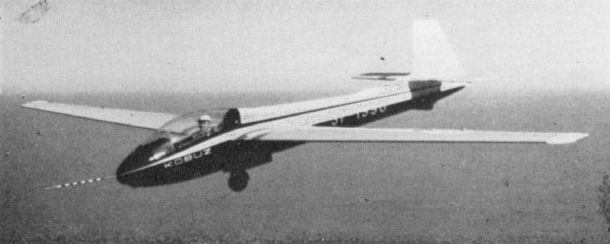
M.Hardy. Gliders & Sailplanes of the world
SZD-21-2B Kobuz 3
One of the very few sailplanes designed especially for aerobatics, this high performance single-seater first flew in prototype form as the SZD-21-2 Kobuz 2 on 3 June 1961, and was designed by Trzeciak. lt was developed into the Kobuz 3, the prototype of which was built at the No 4 ZSLS (Sport Aviation Equipment Plant) at Wroclaw, and flew for the first time on 10 December 1964, piloted by S. Skrzydlewski; an initial production batch of three Kobuz 3s followed in 1965. The Kobuz 3 differed from the Mk 2 in having the cockpit moved forward and the pilot in a semi-reclining instead of a fully-reclining seat, a slightly longer and more pointed nose, a wing of 0.5m greater span with plywood stressed-skin covering, and a taller fin and rudder with the low-set tailplane moved back to underneath the rudder. The Kobuz 3 is stressed to airframe limits of + 7G to -5G, and has a cantilever mid-set laminar flow wing built as a sparless torsion box structure with plywood and foam sandwich skinning; the two-section ailerons are fabric-covered and flaps as well as air brakes are featured. The monocoque fuselage is built in two portions and is covered with a glassfibre and plywood skin; the cockpit has provision for an oxygen installation and R/T radio. A manually-retractable monowheel is fitted, plus a tail bumper. The cantilever tail unit is structurally similar to the wing, and has a fabric-covered rudder and elevators.
Data: Kobuz 3
Span: 45 ft 11 1/2 in
Length: 23 ft 7 1/2 in
Height: 6 ft 3 in
Wing area: 145.3 sqft
Aspect ratio: 14.52
SZD-22 Mucha Standard
This high performance Standard Class single-seater had its origins in the well known IS-2 Mucha (or Fly) intermediate single-seater of 1948, which was produced in several versions and used in some numbers by the Polish gliding clubs; the Mucha-ter set up several national records for altitude and distance, and the type achieved several Diamond C flights. The IS-2 Mucha had a single-spar high wing with an aspect ratio of 15, and was fitted with dive brakes and spoilers; the fuselage was of elliptical cross-section. The Mucha-ter was developed into the SZD-12 Mucha 100 of 1953, this single-seater being used for training. It was of all-wood construction, the cantilever high wings having a single main spar and an oblique auxiliary spar, with a plywood-covered leading edge torsion box; air brakes were fitted and the ailerons were aerodynamically and mass balanced. The oval-section fuselage was plywood-covered and the pilot sat under a one-piece Plexiglas canopy. Landing gear consisted of a monowheel and short front and rear skids sprung with rudder pads.
The SZD-22 Mucha Standard was a further development of the Mucha 100 designed by R. Grzywacz especially for the 1958 World Championships held at Leszno in Poland and, flown by Adam Witek, came 1st in the Standard Class section of this event. The next year it entered quantity production as a replacement for the Mucha 100 and the SZD-8 Jaskolka and over 150 were built in several versions. The SZD-22B had a plywood-covered wing and the SZD-22C a fabric-covered one, the type having the same all-wood construction with a single main spar and an oblique auxiliary spar as the Mucha 100; air brakes were fitted in the upper and lower surfaces, and the fabric-covered Frise ailerons were aerodynamically and mass balanced. The Mucha Standard was one of the first production sailplanes to have provision for water ballast, which was carried in the inboard leading edge. The fin and rudder differ from the Mucha 100's in having a squared-off top and a straight trailing edge. The plywood-covered oval-section fuselage had a very similar landing gear to the Mucha 100's, with a monowheel and front and rear rubber-sprung skids; the SZD-22D had a modified skid and monowheel and the last variant, the SZD-22E, introduced a new wing. The pilot sits under a streamlined clamshell Plexiglas canopy and is provided with a collapsible chart table as well as the conventional instruments; an oxygen installation can also be fitted. A special experimental high altitude version of the Mucha Standard was also developed, with the cockpit modified for flights at heights above 39,000ft.
Span: 49 ft 2 in
Length: 23 ft 0 in
Height: 5 ft 3 in
Wing area: 138.2 sqft
Aspect ratio: 17.6
Empty weight: 529 lb
Max weight: 772 lb
Max speed: 155 mph (in smooth air)
Min sinking speed: 2.4 ft/sec at 44 mph
Best glide ratio: 27.8:1 at 47 mph
- M.Hardy. Gliders & Sailplanes of the world
Фотографии
-
Jane's All the World Aircraft 1966 / 05 - Sailplanes
SZD-21 Kobuz single-seat high-performance sailplane
-
GL 1982- / M.Hardy - Gliders and Sailplanes /Gliders & Sailplanes of the world/ (1)
Регистрационный номер: HB-686 SZD-22 Mucha Standard.
-
Jane's All the World Aircraft 1964 / 03 - Sailplanes
SZD-22C Mucha-Standard operated by the Polish Air Force Association Gliding Club in the U.K.
- Фотографии


